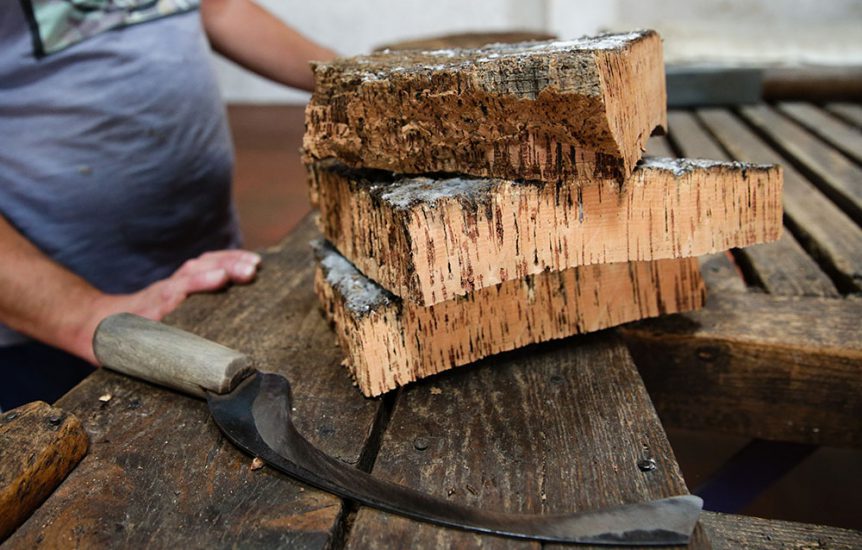- No products in the cart.
It is from May to the end of August, a more active time for the cork growth, that the cork harvesting is done. Cork is a raw material with unique characteristics that, to be extracted, needs great expertise of the cork harvester.
Being an old art and very present in the interior of the Algarve, Mar d’Estórias went to understand the knowledge and the ability needed to harvest the cork from the tree. We went to Reguengo, near Rogil, where we spoke with the specialist António Campos, known as António da Espantadiça, who welcomed us with the calm and sympathy that characterises him.
Antonio explained that it takes 25 years for a tree to start to produce cork, being the first harvest known as “desbóia”. This first cork has little commercial value because it is irregular and too hard to be easily handled, so it is intended for the production of floors and insulation. The so-called “virgin cork” is therefore milled for various uses.
Nine years later, the second harvest (“secondary cork”) produces material with a regular structure, less hard, but still not suitable for cork stoppers.
At age 43 the “cork amadia” (third harvest) is extracted and has the ideal properties for the production of quality corks – of regular and smooth composition. From then on, every 9 years, the cork will supply good quality cork for more than 150 years (18-20 harvests throughout the tree life).
 António da Espantadiça told us that he began to load cork about 40 years ago and only after two years he started to take the raw material from the cork tree: “I started by loading the cork. After some time, the harvester told me to take the “wedges” of the cork tree (the base of the trunk – also known as “shoe”). He saw that I was good at it and, because they needed more people, he then told me to start harvesting as well.”
António da Espantadiça told us that he began to load cork about 40 years ago and only after two years he started to take the raw material from the cork tree: “I started by loading the cork. After some time, the harvester told me to take the “wedges” of the cork tree (the base of the trunk – also known as “shoe”). He saw that I was good at it and, because they needed more people, he then told me to start harvesting as well.”
Usually, they work with a group of 3 or 4 people. At the very least, a harvester and a loader are required, however, ideally, 6 or 7 men are needed to make the 8-hour work effective.
António explains that “the day starts at 8am – the work day is for 8h – 9h, but there are also men who work for 10 hours.” The harvester needs an axe and the loader “a rope and an enxerga” (a kind of cushion so that the cork doesn’t hurt his back). In addition, “two meals are taken – one before noon and one for lunch,” to endure the arduous physical work.
The harvesting has 6 phases:
- Open – With the axe, a vertical cut is made in the cork, and the edge of the axe is twisted so as to separate the outer from the inner bark.
- Separation – Then, with the edge of the axe, separate the plank from the
- Dividing – a horizontal cut defines the size of the cork plank to be removed and what is to remain on the tree.
- Extracting – the plank is removed from the tree with care so that it does not split. The larger the planks extracted, the higher their commercial value.
- Removing – Remove some fragments of cork that remain attached at the base of the trunk.
- Marking – the tree is marked, with the last number of the year in which it was harvested.
It is in the knowledge of the harvester to realise if the cork is thick enough to be removed and not to damage the tree with the extraction. Also, the specialist has to attest to the cork tree health: “There are trees that are “crying” – they begin to produce water in the cork. When this happens, the cork is attached to the inner bark. And if we force and the cork is removed, the inner bark goes off with the cork, and the tree is damaged. If we realise that, we don’t take the cork out of that place so as not to kill the cork tree,” says the master.
After the harvesting, the cork planks are stacked and rest for a month before going to the market, to mature and stabilize the cork: “it can only be weighed a month after it has been taken off. It has to dry for a month because it weighs a lot, “says Antonio.
We must thank these specialists for all these efforts because there is no material in the world like cork. It is a product of excellent thermal and acoustic insulation, impermeable, high resistance to fire and high temperatures, hypoallergenic, excellent elasticity, comfortable and ecological.
Currently, cork is used intelligently in many design products available at Mar d’Estórias shop, as is the case of Likecork that combines cork with ceramics, or As Portuguesas, the first flipflops in the world to use cork as the primary raw material.

